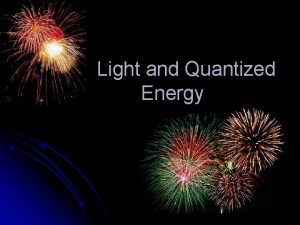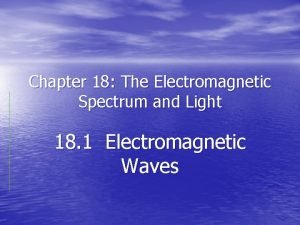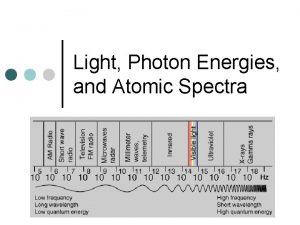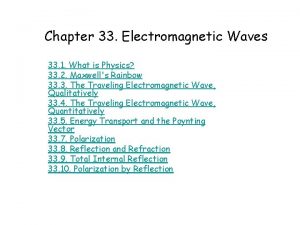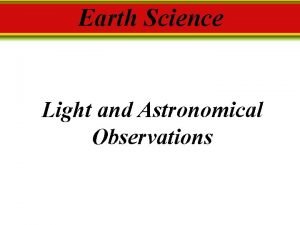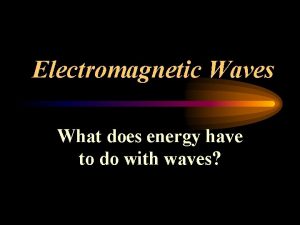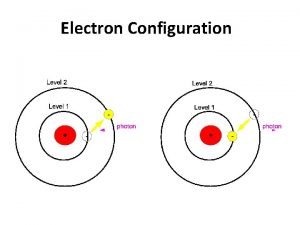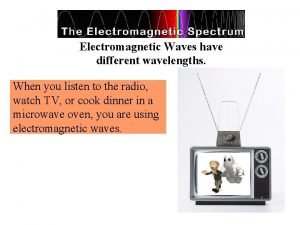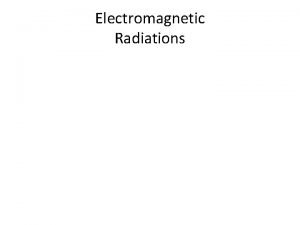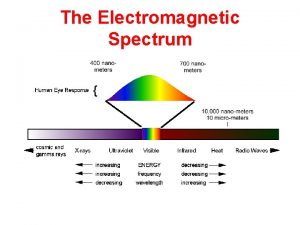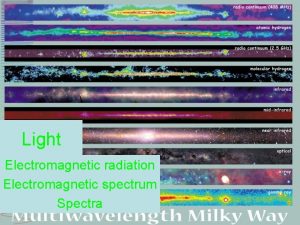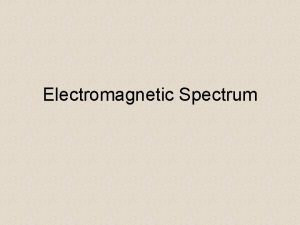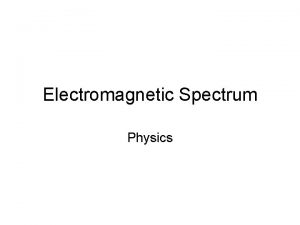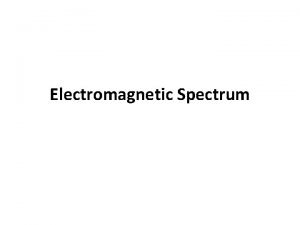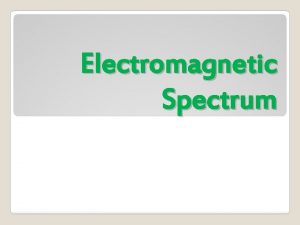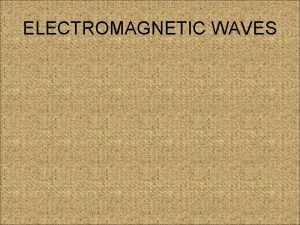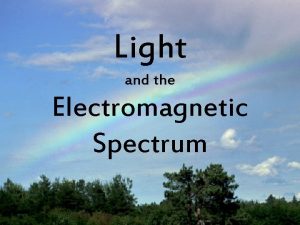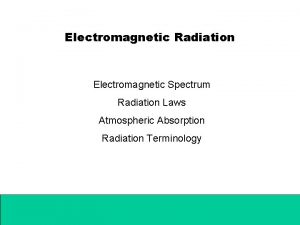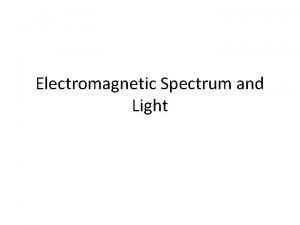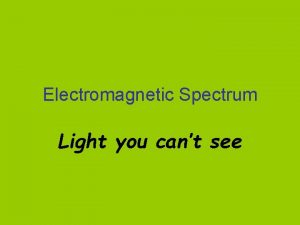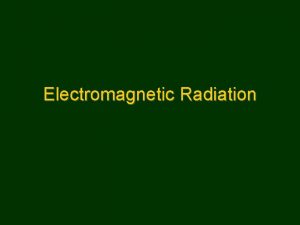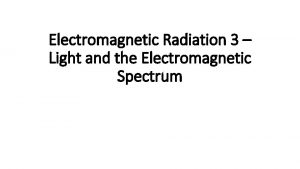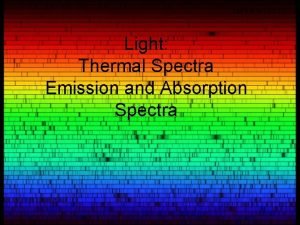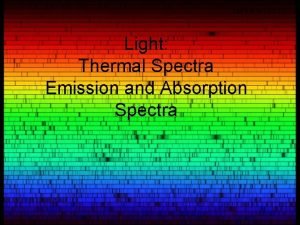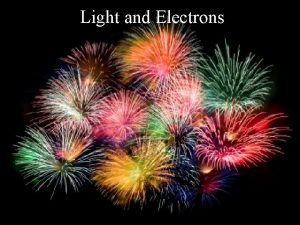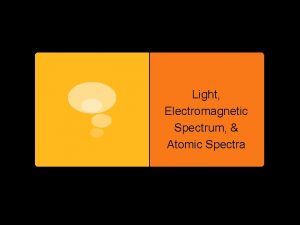Light Electromagnetic radiation Electromagnetic spectrum Spectra Recap Midterm






















- Slides: 22

Light Electromagnetic radiation Electromagnetic spectrum Spectra

Recap • Midterm • Project: due 11/22 • Lab this week: The Power of Light: Understanding Spectroscopy • Masses of galaxies and dark matter – Observational evidence for dark matter: lots of it! – What is it? Don’t know! Probably some new kind of particle – Black holes: probably not dark matter, but still interesting!

I. II. Introduction: Astronomy and Science Astronomy by Eye: Motions in the Sky III. Overview of the Universe IV. The Physical Basis of Astronomy A. B. V. Gravity and Motion Light: why do astronomical objects shine and what can we learn about them by studying the light they emit Interesting questions in astronomy

Light • What is light? – A kind of energy – Electromagnetic energy • Connection between light and the electromagnetic force – Electromagnetic force acts between objects that have electric charge – Acceleration of charged particles produces light – Light incident on charged particles can cause them to accelerate

Characterizing light • Light comes in little packets called photons • Can think of photons as little waves of electromagnetic energy that travel through space • Light waves, like other waves, can be characterized by: – Wavelength: distance between peaks – Speed – Frequency: how often peaks pass a point – Energy: how much work the wave can do

Wave A Wave B Both of these waves travel at the same speed. Which of the following statements is true? A. A has a longer wavelength and a higher frequency than B B. A has a longer wavelength and a lower frequency than B C. A has a shorter wavelength and a lower frequency than B D. A has a shorter wavelength and a higher frequency than B E. A has a longer wavelength, but they both have the same frequency

Light waves • Light waves come in a wide range of different wavelength/frequency/energy – We see different kinds of lights as light of different colors – However, there is also a lot of different kinds of light that we can’t see directly with our eyes at all! – wavelengths of visible light are very short! – For light, wavelength, frequency, and energy are all directly related to each other • Longer wavelengths -> lower frequency -> less energy • Shorter wavelengths -> higher frequency -> more energy

Electromagnetic spectrum • Light of different wavelength/frequency/en ergy has different names, although they are all basically the same underlying thing – Many are familiar from everyday life! • Entire set of different kinds of light called the electromagnetic spectrum

Which kind of light has the longest wavelength? A ) X-rays B) blue light C) radio waves D) all have the same wavelength

Which kind of light has the highest frequency? A ) X-rays B) blue light C) radio waves D) all have the same frequency

Which kind of light has the most energy? A ) X-rays B) blue light C) radio waves D) all have the same energy

Which kind of light travels the fastest? A ) X-rays B) blue light C) radio waves D) all have the same speed

Wave A Wave B If wave A represents green light, what is wave B most likely to represent? A. X ray light B. Blue light C. Red light D. Infrared light E. Radio light

Spectra • Lots of information about objects that emit light can be derived from determining the relative amount of the different wavelengths of light, i. e. . its spectrum • Spectra can be measured using an instrument that sends different wavelengths of light in different directions: a spectrograph – A prism is a simple spectrograph • Several ways of representing spectra: – Show the “rainbow” of colors – Show a graph of the brightness at each color

Classes of spectra • When looking at objects that emit light, one finds they fall into three general categories – Continuous spectra: light emitted over a broad range of wavelengths – Emission line spectra: light emitted only at a few distinct wavelengths – Absorption line spectra: light emitted over a broad range of wavelengths, but missing at a few distinct wavelengths

Colors of objects • The color of an object can give a crude representation of its spectrum • In this respect, the eye/brain is a crude spectrograph, as it sees some objects with different spectra as having different colors – If an object gives off more blue than red, we see it as blue – If an objects gives off more red than blue, we see it as red – If an object gives off equal amounts of all of the visible colors, we see it as white – Problem: can’t distinguish between “pure” blue and “more” blue – Problem: eye only sees visible light!

Here are spectra of three different objects Object C will be A. bluer than object A B. redder than object A C. same color as object A, but brighter D. same color as object A, but fainter

Object B will be A. bluer than object A B. redder than object A C. same color as object A, but brighter D. same color as object A, but fainter

Colors of astronomical objects • Our eyes require a fair amount of light to see different colors: for faint objects, it is difficult to see color in an object • For objects that emit light (like astronomical objects), you can measure a color by looking at the object through different filters – A filter is a material that only transmits light of a certain range of colors – For example, a blue filter only lets blue light through, a red filter only lets red light through – With filters, you can quantitatively measure how much light is emitted from different sections of the spectrum

Classes of spectra: Kirchoff’s laws • The type of emitted spectrum is related to nature of object that is emitting • Continuous spectra: light emitted over a broad range of wavelengths – Produced by warm, dense (opaque) objects • Emission line spectra: light emitted only at a few distinct wavelengths – Produced by hot, low density gasses • Absorption line spectra: light emitted over a broad range of wavelengths, but missing at a few distinct wavelengths – Produced by “cooler” density gases placed in front of continuous sources


To do • Project
 Types of radiation in the electromagnetic spectrum
Types of radiation in the electromagnetic spectrum Light spectrum frequency
Light spectrum frequency Light is electromagnetic wave true or false
Light is electromagnetic wave true or false Chapter 18 the electromagnetic spectrum and light
Chapter 18 the electromagnetic spectrum and light Light light light chapter 23
Light light light chapter 23 Into the light chapter 22
Into the light chapter 22 Light light light chapter 22
Light light light chapter 22 Atomic size defination
Atomic size defination Absortpion
Absortpion When electromagnetic radiation of wavelength 300
When electromagnetic radiation of wavelength 300 Electromagnetic wavelength formula
Electromagnetic wavelength formula Intensity of electromagnetic wave
Intensity of electromagnetic wave Intensity of an em wave
Intensity of an em wave Which telescope detects invisible electromagnetic radiation
Which telescope detects invisible electromagnetic radiation Facts about electromagnetic radiation
Facts about electromagnetic radiation Genchem
Genchem Electromagnetic spectrum with colors
Electromagnetic spectrum with colors The food
The food Electromagnetic spectrum foldable
Electromagnetic spectrum foldable Electromagnetic spectrum
Electromagnetic spectrum Electromagnetic spectrum foldable
Electromagnetic spectrum foldable Shortest to longest wavelength
Shortest to longest wavelength Electromagnetic spectrum foldable
Electromagnetic spectrum foldable
